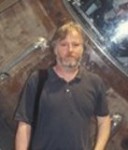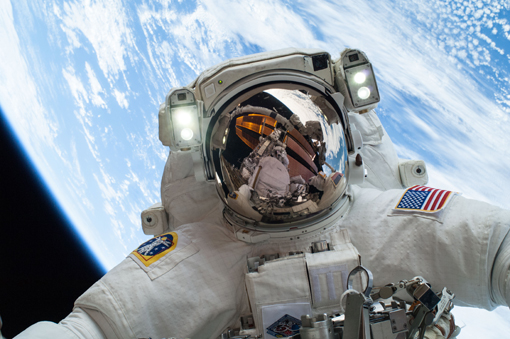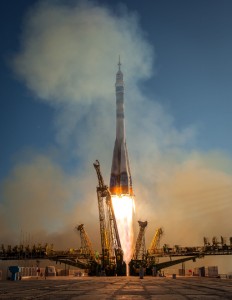Broadcasting Live … From Space
In March 2014 Channel 4 promised to let viewers share live the experience of being an astronaut on the International Space Station. Dr Michael Allen, Birkbeck, University of London, considers the perils and the promise of this claim as the broadcast reaches DVD.
 About the Author: Dr Mike Allen is Senior Lecturer in the Department of Film, Media and Cultural Studies at Birkbeck, University of London. He is the author of several books, including Film and Digital Technologies (Polity Press, forthcoming); Live From the Moon: Filming and Televising the Space Race (I.B. Tauris, 2009); Contemporary US Cinema (Longman, 2002); Family Secrets: The Feature Films of D.W. Griffith (BFI , 1999); and the editor of Reading CSI: Crime TV Under the Microscope (I.B. Tauris, 2007).
About the Author: Dr Mike Allen is Senior Lecturer in the Department of Film, Media and Cultural Studies at Birkbeck, University of London. He is the author of several books, including Film and Digital Technologies (Polity Press, forthcoming); Live From the Moon: Filming and Televising the Space Race (I.B. Tauris, 2009); Contemporary US Cinema (Longman, 2002); Family Secrets: The Feature Films of D.W. Griffith (BFI , 1999); and the editor of Reading CSI: Crime TV Under the Microscope (I.B. Tauris, 2007).
Live From Space was a three-part series of programmes broadcast on Channel Four in mid-March 2014. Two shorter, thirty-minute, documentaries – on astronaut life and the perils of space travel – preceded the final two-and-a-half hour live presentation, which was broadcast in primetime on Sunday 16 March 2014, during one full ninety-minute orbit of the International Space Station (ISS). This marrying of orbit with programme length was the main programme’s central conceit: we would be experiencing ‘live’, in real time, what it is really like to be an astronaut on the ISS as it orbits Earth.
An easy, but rather unhelpful, answer to the question of who this series of programmes was aimed at would be: all armchair space travellers; i.e., virtually all of us who can never reasonably expect to experience a journey into outer space (Richard Branson’s commercial dreams notwithstanding). A more specific (and hopefully erudite) focus would identify a largely young, largely male demographic: child to young adult, with perhaps an older component (those who might affectionately remember the old Space Race of the 1960s). A ‘typical’ viewer would either be a space geek or reality TV fan. As proof of this hypothesis, the show was not only hosted by Dermot O’Leary, self-confessed space geek and reality TV presenter, but was also promoted ahead of its broadcasts in Channel Four output such as 24 Hours in A&E and The Brit Awards 2014.
… the danger of space travel offers the frisson of imminent appalling incident and the contradictory hope of non-event
There are three major identifying features of space travel that are relevant to the present discussion, and two major problems in trying to show them on television, especially live. The first is that much space activity is, paradoxically (given the great speeds at which spacecraft tend to travel), very slow, very painstaking and, to the layman’s eye, often excruciatingly boring. Even the most exciting of activities, spacewalks, take hours to perform and mostly involved indistinct work by astronauts huddled to the sides of spacecraft; not an instant recipe for exciting television. The appetite now is for more concentrated, dramatic, action.
But not too dramatic. The second feature, the antithesis of the first, is that there is an ever-present, any-second, possibility of catastrophic failure: of the spacecraft; of the spacesuit; of the fragile conditions which allow humans to exist in outer space. This would certain ghoulishly satisfy the action-hungry appetite just alluded to, but in the most appalling way. Memories (for the older members of the audience at least) of the life-and-death race back to Earth of Apollo 13 in 1970, crippled by a massive explosion while on the way to the Moon, or (for the younger viewer) of the mid-air disintegration of the Challenger Space Shuttle during lift-off in January 1986, are still collectively fresh in the mind. The intense danger of space travel on live television offers both the frisson of imminent appalling incident and the contradictory hope of non-event for its audience.
The third feature, presenting amazing images of the universe and, more specifically, planet Earth, has been a feature of televised space travel since the 1960s. Apollo showed us ever closer images of the Moon as each mission approached, landed, and retreated from it; as well as of our own planet in beautiful, increasingly detailed images, culminating in the Whole Earth image taken from Apollo 17, which helped to kick-start the global environmental movement. Live From Space boasted similar images taken by High-Definition cameras, and the frequency with which these were presented to the viewing audience throughout the programmes, and especially the live broadcast, made them one of the selling points of the whole project. A telling difference, however, is that there was no capability to give us another Whole Earth. Low Earth orbit restricts us to close-ups of the Earth’s surface, not the majesty of the planet suspended in the blackness of outer space. The profundity of vision is inevitably compromised; brought back down to Earth, one might say. And yet, there may be a significant payoff for this relatively myopic vision, which I will finish on a little later.
… here, the programme delivers big time; indeed, almost to the point of over-determination
The two shorter programmes were effectively representational markers of the first two traits, the two extremes of space travel in the current, Earth-orbit, age. The first programme detailed life as an astronaut in its everyday mundanity. The ISS ceaselessly orbits the Earth (sixteen times a day, we are told), and the astronauts methodically perform their work routines for months at a time: workaday repairs; exploratory scientific activity; adaptive ablutions; food packages from home, delivered via supply rocket. Little of this is particularly arresting, televisually. The second programme addressed the dreaded other extreme: the constant presence of imminent disaster. It focused on an incident when an astronaut nearly drowned during a spacewalk, when his drinking tube leaked water into his helmet. After a dramatic recovery, he survived; but the programme served its purpose – to present the ‘extreme danger’ quotient of space travel.
There is some sense of a clearing of decks here, of attempting to pre-address aspects of space travel that the producers didn’t want the live programme to be concerned with. It is as if the two shorter programmes are suggesting that what they cover could happen during the live show, but won’t; so viewers should tune in and watch what other exciting aspects of space travel the series has to present them with.
But this is not, in fact, what happens. The main programme partly, and simply, reiterates the issues, and indeed at times the content, of its preceding shows. The two on-board astronauts show us around the ISS, including the experiments ‘room’ and their sleeping quarters. We see what they eat and how they keep fit. So far, so comfortable. In an attempt to cover the danger aspect, pre-recorded segments explain how much of a continual threat collision with rogue space junk is to the ISS. The extreme danger of launch and re-entry are also stressed at several points during the show, both in pre-recorded segment and in conversation with the co-hosting astronauts.
But all of this is an excitement that will never be permitted to happen, or at least never shown during the programme. Grisly death live on television is very much not a part of the programme’s agenda. And this leaves the ‘ordinary’ activity: the goofing about with toothbrushes and basketball games in zero gravity. The inherent lack of eventfulness of modern day, Earth-orbit, space travel is tellingly summed up in a pre-recorded event taken from one of the earlier shows: the excitement of a food package from the astronauts’ wives and the sharing of real tortillas rather than freeze-dried space food. We are a very long way indeed from the drama and euphoria of Apollo 11’s touchdown onto the Moon’s surface with less than thirty seconds of fuel remaining in the tank.
We are left, therefore, with the third feature – the wonder of the universe and the sharing of its realisation in awesome television images. Here, the programme delivers big time; indeed, almost to the point of over-determination. We open the live show with images of California and the Baja Peninsula and at regular intervals we are shown further montages of equally breath-taking images: of the South-West of England and London (specially for the Channel Four audience), for example, and of Egypt and the Suez Canal. We are shown what thunderstorms and the Northern Lights look like from above looking down on the planet, rather than below looking up from it. These are amply presented to us in glorious High-Definition; a far cry from the blurry black and white images of Earth from the early Apollo missions, or even the clearer colour images from the final ones.
Furthermore, some of these are put into thought-provoking context by astronauts past and present. Chris Hadfield (famous now for his rendition of Bowie’s Space Oddity), for example, talks of the environmental damage that has been witnessed in progressive generations of such imaging across the past twenty years. Others talk of their heightened sense of the fragility of the Earth as our planet as we look at images of the thin layer of atmosphere that separates us from outer space. And before the cry goes up that such commentary could have been made from images captured by man-less satellites, it is the human dimension, of humankind actually looking down at the earth him- or herself, of us as television viewers sharing that vision, that manifests the profundity.
… It is the wonder of the universe and humans’ place within it that continues to enthral television audiences
And, hence, may be why we agree to spend the two hours of real time with the two ISS astronauts. They are our eyes in space, the real vision to our High-Definition substitute. While we cannot (even if we had the ‘right stuff’) get out of our armchairs and see the views of our planet as they can, through this mediating televisual process we can link to them and get some sense of what it is like to see our fragile planet through human eyes.
It is this aspect of space travel – the wonder of the universe and humans’ place within it – that continues to enthral television audiences, even in this multi-channel day and age. (Witness the relatively large audience figures of BBC TV’s recent Stargazing Live.) We are endlessly fascinated by our ability to go beyond our terrestrial circumstances and look back on our condition. Whatever other restrictive framework Live From Space offered us – the somewhat artificial conceit of an orbit length programme duration; a false sense of that event occurring ‘live’ when half of the programme was pre-recorded – it was, as it is always, those images of our planet and its features that still have the power to awe us.
But more so, the ultimate ‘message’ of the programme(s) – somewhat perversely, perhaps somewhat unintentionally – is that it is not enough just to go on relentlessly orbiting our own planet, seeing (and photographing) the same close-up views of countries, the same Pacific Ocean (specifically singled out as the repetitive experience by the astronauts) and other Earthly delights. Humans need to escape this Dantesque nth circle of Hell and return to ‘true’ space exploration: of the wider Solar System. Or more modestly, at least in the first instance: Mars. The last section of the programme, symbolically following the loss of signal with the ISS, shows Professor Stephen Hawking meditating upon the human need to explore new worlds (‘exploring is in our DNA’) as animations show what manned exploration of the Mars’ surface may look like. Television programming which advertises itself as unmissably awe-inspiring, only to ‘fess up’ at its end that what it has shown us is not enough, and that better, bigger, more adventurous images are demanded, is either very naïve or extraordinarily adventurous in itself. It is in the eye of the beholder which one Live From Space actually is.
Dr Mike Allen
Email: m.allen@bbk.ac.uk
Read our 2011 review of Dr Mike Allen’s book Live from the Moon: Film, Television and the Space Race.
 Learning on Screen
Learning on Screen